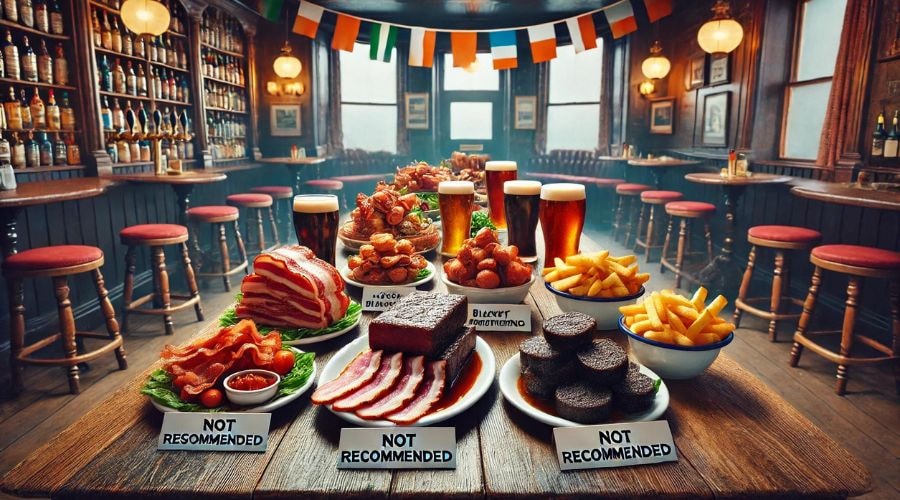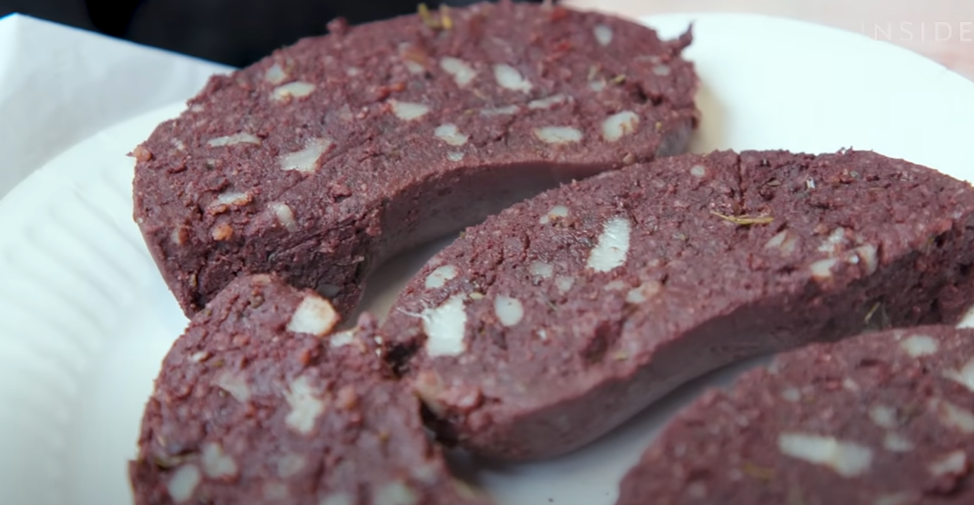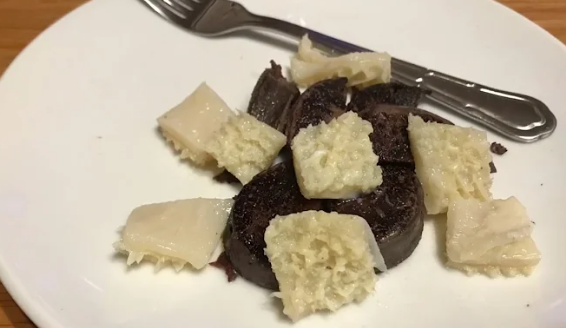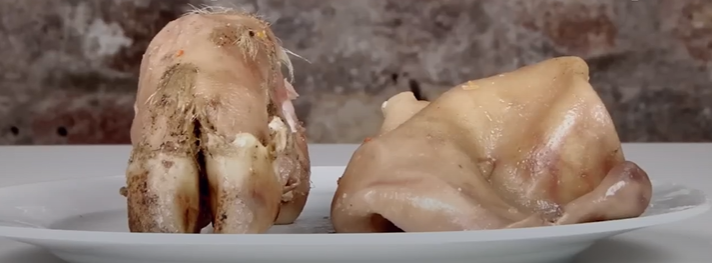When visiting Ireland, it's important to know which foods might not suit your taste or dietary needs. While the country offers a rich culinary scene, some items may be best avoided to ensure a pleasant dining experience. Stay away from overly processed foods and certain traditional dishes if you're unsure about their ingredients.

From my travels, I learned to steer clear of certain dishes. I once had a less than pleasant experience with a very traditional dish that was too adventurous for my palate. It's always a good idea to ask locals for recommendations and check how the food is prepared. This way, you can enjoy delicious meals that are also safe and enjoyable.
Irish Dishes to Approach with Caution
When considering what not to eat in Ireland, some dishes might require caution due to their unique ingredients or preparation methods. Traditional Irish food like black pudding, made from blood and fillers, and white pudding, can be off-putting for those unaccustomed to their taste and texture. Additionally, certain seafood dishes, such as fresh fish served raw or sea urchins, may not suit everyone's palate and can cause digestive discomfort if one is not used to them.
Furthermore, dishes featuring heavy use of cream and Irish butter, like some rich Irish stews and cottage pie, could pose problems for those with lactose intolerance. It's essential to inquire about the ingredients if you have dietary restrictions or allergies. Lastly, while not common, wild game dishes such as pigeon or rabbit may carry a distinct flavor that might not appeal to everyone. Notably, traditional Irish food such as a full Irish breakfast, including potato bread and Irish butter, offers a more filling meal but could be excessive for those with a lighter appetite.
Black Pudding

When exploring the culinary landscape of Ireland, one might consider approaching black pudding with a degree of caution. This dish, deeply embedded in traditional Irish cuisine, consists primarily of cooked pork blood mixed with pork fat or beef suet, and oatmeal, which is then stuffed into a sausage casing. Black pudding is a staple in the classic Irish breakfast and is celebrated for its bold flavors and rustic origins.
Reasons to approach black pudding with caution include:
-
Unfamiliar Ingredients: The main component, pork blood, may be unappetizing to those unfamiliar with blood-based foods, which are not common in many cultures.
-
Dietary Restrictions: It's unsuitable for vegetarians, vegans, and individuals who abstain from pork for health or religious reasons. The presence of animal blood and fat also makes it a high-cholesterol food, which could be concerning for those with dietary restrictions involving cholesterol or saturated fats.
-
Taste and Texture: The distinctive taste and dense, grainy texture of black pudding can be quite polarizing. While some appreciate its rich, iron-heavy flavor, others might find it overwhelming or unpleasant.
-
Cultural Differences: For travelers and those not raised in Ireland or the UK, the concept of eating blood as a component of breakfast might seem daunting or unappealing.
Despite these points of caution, many find black pudding to be a delightful and essential part of Irish culinary tradition. It is often enjoyed fried or grilled alongside eggs, tomatoes, and bread, providing a hearty, flavorful start to the day. Enthusiasts of the dish appreciate its deep connection to Irish heritage and its role in a hearty, traditional breakfast. If you're adventurous with your food choices, black pudding could be a uniquely Irish experience to try.
Tripe and Drisheen

In Ireland, including the region of Northern Ireland, Tripe and Drisheen are two traditional Irish foods that might not suit everyone's taste or dietary preferences, somewhat akin to the acquired tastes of Irish breakfasts. Here’s why these items deserve a cautious approach:
Tripe, made from the stomach lining of various farm animals, often has a rubbery texture and a distinct, somewhat musty flavor. This can be off-putting to those unaccustomed to eating organ meats. It's similar in its divisiveness to the notorious Irish Car Bomb cocktail, which also polarizes opinion.
Drisheen is a type of blood sausage, rich in iron but with a unique, metallic taste that may not appeal to all palates. Its gelatinous texture, derived from mixed animal bloods, including sheep, cow, and pig, combined with milk, salt, and fat, requires an adventurous eater, much like deciding between traditional dishes and international favorites like French fries.
Why to Approach with Caution:
-
Allergenic Potential: Both tripe and drisheen contain ingredients that can trigger allergies, such as lactose in drisheen.
-
Acquired Taste: The flavors and textures are quite distinct and may be challenging for first-time tasters.
-
Preparation Variance: Cooking methods can vary greatly, which affects the final taste and texture, potentially leading to unexpected dining experiences.
These dishes, integral to traditional Irish cuisine, reflect the culinary heritage and resourcefulness of Ireland but are best approached with a bit of caution if you're unfamiliar with them.
Crubeens

Crubeens, a traditional Irish dish, often piques curiosity among visitors but should be approached with caution if you're exploring Irish culinary traditions for the first time. This unique dish is made from pigs' feet, which are cleaned, boiled, seasoned, and often deep-fried until crispy. It embodies a deep-rooted aspect of Ireland's culinary history, primarily popular in rural areas where no part of the animal was wasted. While crubeens provide an authentic taste of traditional Irish fare, they might not appeal to everyone's taste preferences or dietary choices.
Reasons to approach crubeens with caution include:
-
Texture and Taste: The primary challenge comes from their gelatinous texture and potent flavor, which are far from the more universally palatable parts of the pig used in other dishes. For those unaccustomed to eating unconventional parts of animals, crubeens can be particularly challenging.
-
Preparation Method: Crubeens are often deep-fried, leading to a high fat content. While this method enhances the flavor and gives them a crispy texture, it also increases the dish's caloric and fat content, which might not align with healthier eating practices.
-
Nutritional Content: Given their richness in fats and cholesterol, crubeens are not recommended for those on heart-healthy or low-cholesterol diets. The nutritional profile can be concerning for individuals monitoring their intake of saturated fats and cholesterol.
-
Acquired Taste: Crubeens are definitely an acquired taste. Their strong, distinctive flavor and unusual texture can be off-putting for those who prefer more conventional meats or are less adventurous in their eating habits.
-
Cultural Significance vs. Personal Preference: While crubeens hold a significant place in traditional Irish cuisine, particularly among older generations or in more traditional settings, modern culinary trends and changing dietary preferences might influence visitors' willingness to try such a distinctive dish.
For visitors to Ireland looking to immerse themselves in all aspects of local culture, including cuisine, crubeens offer a unique opportunity. However, it's wise to consider your own dietary preferences and restrictions before diving into this traditional Irish specialty. Those seeking to experience Ireland's culinary diversity can certainly find crubeens an interesting dish to sample, albeit one that might require a bit of culinary bravery.
What Mistakes To Avoid While Dining in Ireland?
When considering what mistakes to avoid while dining in Ireland, it's essential to understand and respect the local dining customs to fully enjoy your experience. From skipping traditional dishes to misinterpreting pub culture, each mistake can have a significant impact on your culinary journey.
To ensure a more authentic and enjoyable dining experience during your visit, here are some important missteps to avoid:
Not Trying Traditional Irish Dishes
One of the biggest mistakes you can make while dining in Ireland is bypassing traditional Irish foods. Dishes like Irish stew, made with lamb, potatoes, and onions, or colcannon, a delicious blend of mashed potatoes and kale or cabbage, offer a true taste of Irish heritage. Soda bread, another staple, is often served alongside these dishes and is perfect for soaking up broths and gravies. Experiencing these traditional dishes is integral to understanding the heart of Irish cuisine.
Misunderstanding Local Dining Times
In Ireland, the typical dining times are earlier than in many other European countries. Most locals dine between 6 PM and 8 PM, and many restaurants do not serve dinner past 9 PM. Tourists often miss out on dining opportunities by not adjusting to this schedule. It's advisable to plan your meals within this time frame to ensure you get to experience dinner in a traditional setting.
Overlooking Pub Etiquette
Pubs play a central role in Ireland's social and culinary scenes, but they come with their own set of unwritten rules. One common mistake visitors make is waiting at a table to be served. In most Irish pubs, you should order your food and drinks at the bar. Also, it's customary to return your glass to the bar after finishing your drink, especially in busier establishments. Observing these practices shows respect and helps you blend in with the locals.
Neglecting to Tip
While tipping in Ireland is not as obligatory as in some countries, it is still expected for good service, particularly in restaurants. The standard tip is about 10% of the bill. Tipping is a way to show appreciation for good service, and neglecting to do so can be perceived as a sign of dissatisfaction with the service provided.
Assuming Corned Beef is a Local Favorite
Many visitors associate corned beef with Irish cuisine; however, it is not commonly eaten in Ireland. This misconception likely stems from Irish-American traditions. In Ireland, more traditional meats include bacon (not the American kind) or lamb. Opting for these meats will give you a more authentic taste of Irish culinary traditions.
By keeping these tips in mind and avoiding these common dining mistakes, you'll be able to more fully appreciate the rich culinary landscape of Ireland and enjoy a more authentic experience during your visit.
What Allergens Should You Be Aware Of in Ireland?
When exploring culinary options in Ireland, it's crucial to be aware of common allergens that might dictate what not to eat, particularly for those with food sensitivities. Ireland's rich and varied diet includes many potential allergens which, if consumed by someone with allergies, could lead to adverse reactions. Awareness and precaution can greatly enhance the travel experience by preventing allergic reactions.
In Ireland, as in many parts of the world, certain foods commonly cause allergic reactions. The local cuisine, which heavily features dairy, seafood, and wheat, requires particular attention for those with specific dietary restrictions. Identifying and understanding these allergens can help visitors and residents alike avoid health issues and enjoy Ireland's culinary offerings safely.
Dairy
Milk and other dairy products are integral to Irish cuisine, appearing in many traditional dishes, beverages, and desserts. Individuals with lactose intolerance or an allergy to milk proteins should be cautious, as dairy is prevalent in many forms, from butter in baked goods to cream in rich sauces and soups.
Gluten
Gluten, found in wheat, barley, and rye, is ubiquitous in the Irish diet, particularly in staples like bread, beer, and pastries. For those with celiac disease or gluten sensitivity, vigilance is necessary, as gluten-containing ingredients are common in many popular Irish dishes. Always inquire about gluten-free options, which are increasingly available.
Shellfish
The rich seafood traditions of Ireland often highlight shellfish, which can be a significant allergen for many. Dishes featuring mussels, prawns, and other shellfish are popular, especially in coastal regions. It's important for individuals allergic to shellfish to communicate their allergies clearly when dining out to avoid cross-contamination and ensure safe meal choices.
Nuts
Nuts, commonly used in Irish cooking and baking, pose a risk for those with nut allergies. Even small traces of nuts can trigger severe reactions. Due to the risk of cross-contamination in kitchens, it is advisable for allergic individuals to alert restaurant staff to their condition and always carry necessary medication, such as an EpiPen.
How to Stay Safe While Eating in Ireland?
To stay safe while eating in Ireland, it's important to be mindful of certain foods and practices. Avoiding unregulated or street vendors and being cautious with raw or undercooked meats can significantly reduce health risks. Such caution helps prevent foodborne illnesses which might stem from these sources.
Consider these detailed tips for a safer dining experience:
-
Check for Freshness: Always ensure seafood is fresh and that restaurants have positive reviews, particularly for their handling of fish and shellfish.
-
Opt for Pasteurized Dairy Products: Stick to pasteurized dairy items to avoid the risk of contamination from bacteria such as E. coli or Salmonella.
-
Confirm Cleanliness and Certifications: Visit eateries that are visibly clean and have up-to-date food safety certifications displayed. This is a good indicator of their commitment to hygiene.
-
Avoid Highly Processed Foods: Choose whole and natural foods over highly processed items, as these are less likely to contain harmful additives and are generally healthier.
-
Be Cautious with Allergens: If you have food allergies, always inform the server and ensure that the kitchen can accommodate your needs safely.
After implementing these safety measures, your culinary experience in Ireland can be enjoyable and worry-free. Remember, a proactive approach to dining out—such as choosing well-reviewed establishments and opting for quality over convenience—can enhance both your safety and your overall enjoyment of Irish cuisine.
FAQs On What Not to Eat in Ireland?
1. What are some foods to avoid in Ireland?
Foods to avoid in Ireland include overly processed meats and pre-packaged meals that may not give you the authentic Irish culinary experience.
2. Are there any specific Irish dishes that tourists typically do not enjoy?
Tourists often find black pudding challenging due to its blood content and unique texture.
3. Is there any type of seafood to be cautious about in Ireland?
Exercise caution with shellfish if you have allergies or if it is not fresh, as seafood quality can vary by location and season.
4. What should I avoid drinking in Ireland?
Avoid drinking tap water in remote areas without first checking if it's safe, as some regions have untreated water sources.
5. Can I eat street food in Ireland?
While street food in Ireland is generally safe, always opt for vendors that maintain high cleanliness standards to avoid foodborne illnesses.
